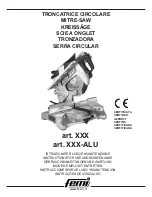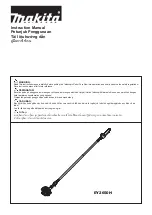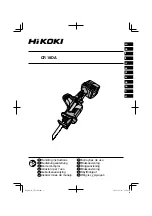
Making Longitudinal Cuts / Ripping
Press one edge of the workpiece against the rip fence while the flat
side lies on the saw table. The blade guard must always be lowered
over the workpiece.
When you make a longitudinal cut, never adopt a working position that
is in line with the cutting direction.
1 Set the rip fence in accordance with the workpiece height and the
desired width. (See
Stop Height, Cutting Width
).
2 Switch on the saw by pressing the ON button "I".
3 Place your hands (with
fingers closed ensuring they
will be clear of the blade) flat
on the workpiece and push
the workpiece along the rip
fence and into the blade.
4 Guide at the side with your
left or right hand (depending
on the position of the rip
fence) only as far as the front
edge of the blade guard.
5 Always push the workpiece
through to the end of the
riving knife.
6 The off cut piece remains on
the saw table until the blade
is back in its position of rest.
7 Secure long work pieces
against falling off at the end
of the cut (e.g. with a roller
stand etc.) .
5. MAKING A CUT
TSF-1211
0º
5º
10º
15º
20º
25º
22.5º
30º
45º
0º
5º
10º
15º
20º
25º
22.5º
30º
45º
Cutting Narrow Work Pieces
Making Bevel Cuts
Making Cross Cuts
Bevel cuts must always be done
using the rip fence.
1 Set the blade to the desired
angle. (See
Setting the Bevel
Angle
)
2 Set the rip fence in accordance
with the workpiece width and
height (see
Stop Height
)
3 Carry out the cut in accordance
with the workpiece width.
1 Slide the sliding mitre gauge into one of the grooves in the table and
adjust to the required angle (see
Sliding Mitre Gauge
).
2 Press the workpiece firmly against
the sliding mitre gauge.
3 Switch on the saw by pressing the
ON button "I".
4 Push the sliding mitre gauge and
the workpiece toward the blade
in order to make the cut.
5 Push the sliding mitre gauge
forward until the workpiece is cut
all the way through.
6 Switch off the saw again. Do not remove the off-cut until the blade
has stopped rotating.
IMPORTANT!
BE SURE TO USE A PUSH STICK WHEN
MAKING LONGITUDINAL CUTS.
Be sure to use a push stick
when making longitudinal cuts
in work pieces smaller than
120mm in width. A push stick
is supplied with the saw.
Replace a worn or damaged
push stick immediately.
IMPORTANT!
DO NOT PUSH THE MITRE GAUGE STOP
RAIL TOO FAR TOWARD THE BLADE. THE DISTANCE
BETWEEN THE STOP RAIL AND THE BLADE SHOULD BE
APPROX. 20MM.


























